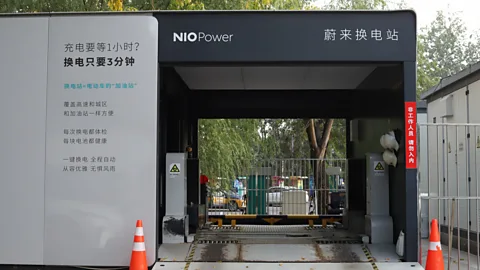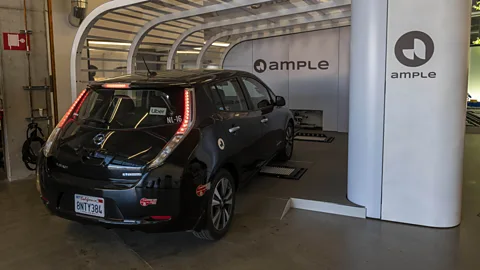For commercial vehicles, such as heavy-duty trucks, taxis and buses, such problems are easier to solve. These vehicles often operate in more predictable patterns, with centralised management, fixed routes or designated service areas, making it easier to plan and coordinate battery swaps efficiently. Battery swapping heavy-duty trucks are currently being widely promoted in China through both government policies and private companies, says Lulu Xue, mobility lead at the China office of the World Resources Institute, a global non-profit.
“The purchase cost of battery electric heavy-duty trucks was very high when they were first introduced, and batteries accounted for a large part of it,” she says. “If the battery is separated from the vehicle and users only buy the vehicle body, the price is almost the same as the purchase cost of diesel trucks.”
 Iris Liu
Iris LiuThe Chinese government has extended considerable financial assistance to battery swapping schemes. In its 2021 pilot programme, three of the 11 cities are primarily focusing on battery swapping for trucks. Some provinces in China have also provided substantial financial incentives for the advancement of battery swapping technology. In 2021, China’s Hainan Province announced a one-time subsidy of 15% of the initial investment in equipment for battery swapping stations built and put into operation between 2021 and 2022.
China has been able to widely promote battery swap stations so quickly since it is home to the main lithium-ion battery manufacturers, and thus has a relatively inexpensive and abundant supply of batteries, according to Yihao Xie, a researcher on heavy-duty vehicles at the Washington-based International Council on Clean Transportation.
Using battery swaps for commercial vehicles also has its obstacles, however. Swap stations can occupy a large area, says Yang, and there tends to be a scarcity of land and power grid resources in the core areas where they are needed, which can constraint rapid expansion. “At present, battery swap operators have tried to deepen cooperation with some traditional energy companies to obtain such core resources,” she adds.
However, Liu points out that battery swap stations are a similar size to petrol stations, which can be easily repurposed to be battery swaps. The China National Petroleum Corporation, for example, has already built both charging and battery replacement facilities at some of its gas stations.
Perks and pitfalls
Some companies are also trying more specialised methods. Like many facilities in China, using land for battery swap stations requires approval and filing, making the entire cycle relatively long, and the land rent also increases the cost of the stations. To avoid these, some companies have developed mobile battery swap vehicles, says Xue, which have the added benefit of being able to charge batteries in locations with lower electricity prices, then swapping them in areas where on-site charging would be more costly or less feasible.
Liu notes that for commercial vehicles, battery ownership concerns are easier to manage, since companies can purchase batteries in bulk or rely on third-party providers. But the issue is still affecting how often at least some drivers of these vehicles use swap stations.
One taxi driver I speak to in Beijing has a taxi with both charging and battery swapping technology, meaning he can choose to charge or swap batteries. The taxi company he works for stipulates that drivers must use the battery swap mode at least once a month as part of a trial. “If I get a good battery, I won’t change it,” he tells me. “I will wait a month before changing it.” Using the battery swap service is also more expensive than charging, he adds.
 Getty Images
Getty ImagesTaxi drivers who get a battery with a poor battery life at the swap station sometimes quarrel with the staff, according to a worker I meet at a Beijing taxi swap station. “If the driver gets a bad battery, some of them will yell at us. I tell them, yelling at us doesn’t help, we’re just here to swap the batteries. Some drivers even say they’ll call the police – it’s happened many times.”
Currently, says Xue, there is a clear business model in China for battery swaps for heavy-duty trucks, especially for intensive but short-distance uses such as in factories and mines.
Xie agrees. “Battery-swapping in commercial vehicles, especially heavy-trucks, is still faster than the fastest charger technologies currently in the market,” he says. “Trucks carry batteries with much larger capacities and those are just slower to charge until much more powerful chargers become available.” These advantages are unlikely to weaken even as fast charging technology develops, he adds.